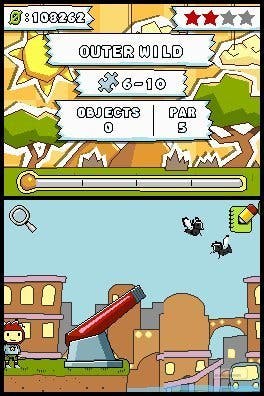Scribblenauts
Write power!
I just feel sorry for the guys on GameFAQs. They do such a difficult job for so little, and once Scribblenauts comes out they're going to do their usual amazing work, explaining how they overcame all of its many puzzles with objects summoned into the world using the staggeringly versatile Writepad, and then they're going to get hundreds of emails going, "No, you're wrong, you don't glue a pillow to the spike and then fly up with a jetpack, you get the Starite by putting a table over the spike and then electrocuting the shark and putting on a diving suit. IDIOT." At least we can probably agree that a brick is the best way to hit the switch. (Or, thinking about it, you could fly a jetpack up there and do without the brick, therefore using an object fewer and getting a better par time.)
Games that empower you to solve puzzles with creative tools are easy to get excited about, so it's no surprise that Scribblenauts has everyone falling over themselves at the very concept. The common goal is to do something with objects you've pulled into the 2D world by writing their name down with an on-screen keyboard. Using a system called Objectnaut, summed up in our first preview, developer 5th Cell has been able to handle possible relationships between objects elegantly, so if something emits fire the game will understand what it can burn intuitively rather than having to be told. This has given the small team more time to draw and label things for use in the game. Pretty much the only things you can't have are copyrighted items or filth.

There's a danger with relying so much on the player's imagination, of course, as we discovered with Crayon Physics Deluxe, a game where you had to transport a ball to a star by drawing shapes and building contraptions out of them: as soon as solutions became elusive, it was much too easy to pull out a box, rope and weight and shortcut levels completely. But Scribblenauts manages to evade this for the most part. You might use a jetpack quite a lot, but 5th Cell boxes levels in to compel innovation, and in practice you're compelled to play around anyway because of the unprecedented wealth of possibility. As one E3 attendee discovered and then related to NeoGAF, zombie robots are no match for a dinosaur you've recovered from the past using a time machine. 5th Cell is paying attention to feedback too, and even celebrates it: if you buy Scribblenauts, try summoning "post two one seven".
There are two types of level to play through - Puzzle and Action. Puzzle levels give you some props and a clue - there might be few flowers dotted around and a woman with a basket, and you have to use your character, Maxwell, to deliver flowers to her to be awarded the level-finishing Starite. Action levels simply show you the Starite somewhere on the screen and leave you and Maxwell to find a way to retrieve it - there might be switches and doors in between you and it, or a tornado, or, indeed, virtually anything you can imagine. Almost everything I've typed in after clicking on the Writepad icon has come to life and behaved as expected: I've driven cars, thrown baseballs, trampolined onto high platforms, deployed lions to fight witches, and glued pictures to walls (items have attachment points that allow you to string them together where practical, although they can only be pinned to real-world objects rather than the level walls). The game even understands that Brits don't use the same terms as Yanks, so I can ask for a bin and you can ask for a trashcan boy howdy.




